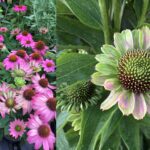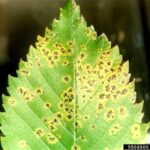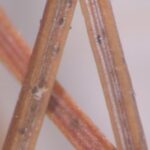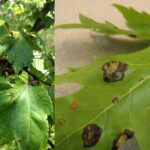Aspen, cottonwood, and poplar are all names for the fast-growing Populus tree species. Used widely for building materials, these trees are often located around ponds, riverbanks, and sloping areas toward water bodies (especially cottonwood). Cottonwood flowers produce little white tufted seeds that float through the air which a lot of people love (my kids included),[Read More…]
Purple coneflower, Echinacea purpurea, is an old native standby that can thrive even in some difficult landscapes. With beautiful purple flowers and the ability to reseed and fill an area, it has been used widely, especially in gardens comprised primarily of native plants; however, they are not without their problems. We sometimes see some fungal[Read More…]
Cherry, plum, almond, peach and cherry laurel all get a common issue called shot hole leaf spot. At first, a chlorotic or necrotic spot develops on the foliage (Figure 1). When a tree has severe symptoms, the leaves may drop prematurely from the tree. If the leaves remain on the tree, the leaves produce a[Read More…]
Hypoxylon canker is a common disease of mature hardwood trees both in landscapes and in natural wooded areas. The disease, caused by the wood decay fungus Biscogniauxia (formerly Hypoxylon), is most frequently observed in oak tree species, but can also cause dieback in pecan, hickory, golden rain tree, sycamore, maple, beech, birch, elm, willow, basswood,[Read More…]
Plants that show little growth, are stunted, or are wilted and in active decline are all hallmarks of root stress. Some of the more prominent pathogens that cause root rot include Fusarium, Phytophthora, Pythium, and Rhizoctonia, but there is another fungus which can cause just as much damage in the right situation that does not[Read More…]
We have received a few elm tree samples this year with a disease we do not often see, but which is relatively common: black spot of elm. This disease, also called elm anthracnose, is caused by the fungus Stegophora ulmea and can affect most species of elm with American elm varieties being more susceptible. The[Read More…]
Early June, we received a white pine sample at the Purdue University Plant and Pest Diagnostic Lab that showed early season needle loss lower in the tree canopy (Figure 1, 2). The majority of conifers hold onto their needles for multiple years, so loss of needles, even in the fall, can come as a shock[Read More…]
The past two months have been relatively wet and cool to warm. This prolonged period of overcast conditions, high humidity, and light to moderate rainfall is perfect for some of our foliar disease issues. “April flowers bring May Leaf spots” doesn’t have the right ring to it, but we are seeing quite a bit of[Read More…]
Vascular streak dieback is an emerging issue on woody ornamentals in the nursery industry. We have provided information on this topic as the situation has been unfolding (https://purduelandscapereport.org//article/vascular-streak-dieback-of-redbud-what-plant-pathologists-know-so-far/; https://indianagreenexpo.com/sessions/vascular-streak-dieback-an-emerging-issue-in-nursery-stock/). Researchers and Collaborators working on vascular streak dieback will be presenting up-to-date information during the tHRIve webinar hosted by Horticultural Research Institute on Thursday, April 11,[Read More…]
I think white pines are beautiful trees, especially at maturity, and they have the added advantage that they are one of the few conifers that don’t try to kill you with their needles. Besides working with the foliage, have you ever had to “rescue” a child who climbed too high in a spike-infested deathtrap of[Read More…]
Inonotus dryadeus is one of the more common wood decay fungi we receive at the diagnostic lab in association with declining trees, specifically oaks. Inonotus is found so frequently on oaks it has the common name oak bracket fungus, but it can cause root rot of a number of other hardwood trees (including maples, sweet[Read More…]
Many trees are planted for their beautiful fall color, especially in locations where the climate provides reliable autumn weather. I have said this multiple times during extension talks and conversations with submitters to the PPDL, but I seem to have not experienced a ‘normal’ fall since moving to Indiana with how erratic the weather has[Read More…]
In the last five years, we have received 233 samples from Indiana, alone, with concerns ranging from boxwood leafminer to Volutella dieback and cold damage (Figure 1, 2, 3). Often, we find multiple problems on any given sample, and very frequently we see Volutella in association with dark cankers of stems that appear to have[Read More…]
Periwinkle (Vinca minor) has a few disease issues that can cause severe damage to Vinca in cool wet weather, including Rhizoctonia stem and crown rot, Phytophthora root and crown rot, and Phoma stem blight. The last disease, Phoma stem blight, can cause severe damage to Vinca early in Spring when new stem growth emerges (Fig[Read More…]
There have been a number of samples we have received at the PPDL in recent weeks that bear similar problems worth noting. It is still relatively early for significant in-season disease development due to how cold it has been, although we have certainly had enough rainfall to encourage fungal growth. We have received multiple samples[Read More…]
A new disease called Beech leaf disease (BLD), associated with native and ornamental beech trees (Fagus spp.), has been making its way eastward from Lake Erie. First observed in 2012, trees show dark interveinal leaf banding, deformation of the banding tissue, and leaf curling under increased disease severity. Leaves can be stunted and leathery in[Read More…]
Lilacs (Syringa spp.) are some of my favorite plants alongside Ginkgo (males, at least) and while I could wax poetic about their great aesthetic characteristics I will just say that they have beautiful spring flowers and they smell great, too. However, they do have a handful of problems that cause them to look a little[Read More…]
While recent temperatures have been moderate in many parts of the state, rainfall has been lacking. (See The Annual Drought Article). There are chasms in the clay of my backyard that will swallow my kids and dogs whole. While I am not truly worried about the safety of my smaller family members, a lot of[Read More…]
When we see round holes in the bark of a tree we often think the cause might be due to wood boring insects or bark beetles. However, that is not always the case. Small holes arranged in neat, uniform rows and columns on the trunks of trees or woody shrubs are usually caused by sapsuckers,[Read More…]
Determining the cause of dieback and decline symptoms in landscape trees can be very difficult due to the many cultural, environmental, and biological factors that could be involved. The first place you should look for a culprit when dealing with this type of tree problem is the base of the trunk and the roots. Stem[Read More…]




















